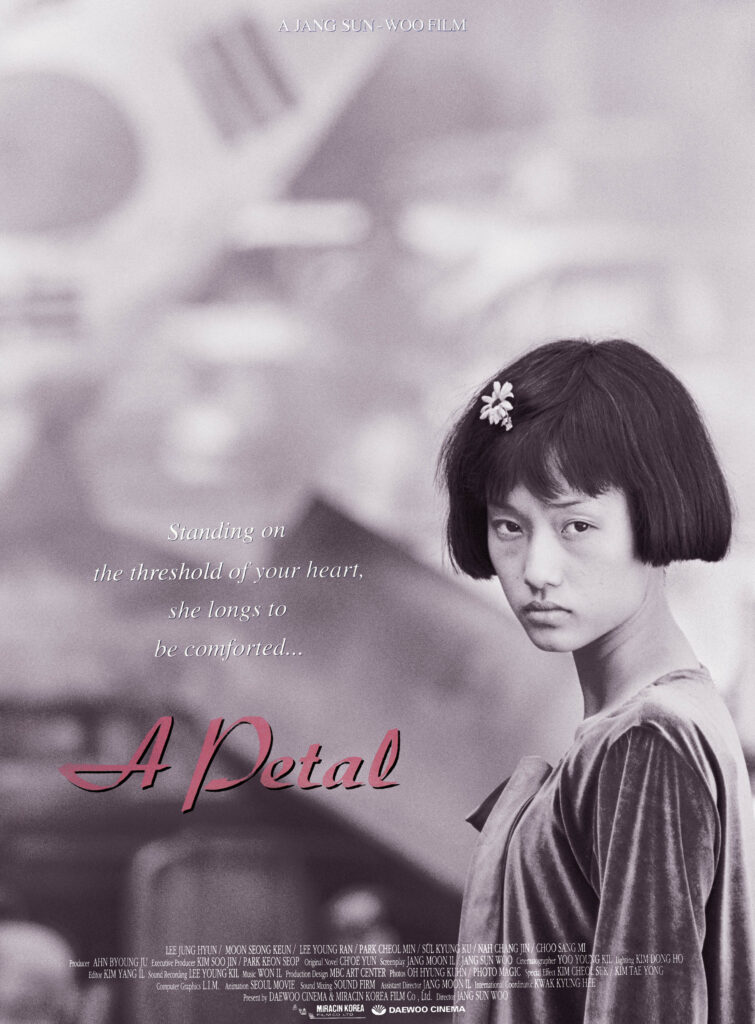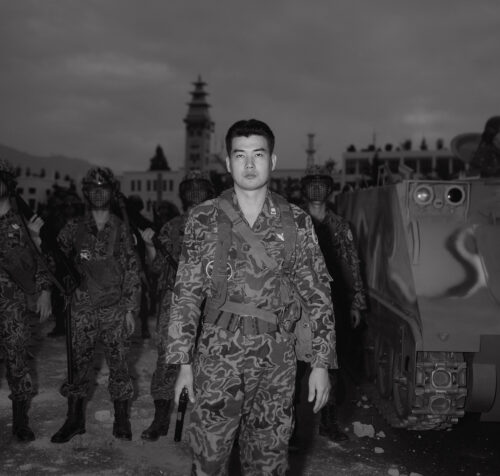Confronting Resurgence of the Trauma: Gwangju Story
©Young Min Moon
Hein-kuhn Oh’s Gwangju Story represents the mass subjects who seem to be troubled as they confront the unfolding of the history once believed to be deeply buried in their minds. The history they are facing is a reenactment of Gwangju Uprising of May 18,1980, arguably the single most important traumatic event in the history of democracy movement in South Korea. The military force supported by the U.S. crushed the student-led anti-government movement, resulting in much-disputed civilian death tolls, ranging from 372 to some 2,000, according to various sources.

 In 1995, Hein-kuhn Oh was commissioned to photograph the making of the film A Petal. The reenactment scene of Gwangju Uprising involved participation of some three thousand Gwangju civilians who assumed various roles of special military force, riot police, and demonstrators. In addition, some three hundred real police were deployed in an anticipation of possible eruption of yet another real demonstration. Oh’s version of the story is not about how Gwangju Uprising unfolded, but rather the self-conscious reactions and demeanors of the participants and spectators. The result is not so much a documentary of the making of the film per se, but rather a record of Gwangju citizens engaged in the impossible task of reconstructing the collective memory of Gwangju Uprising as a fictional reconstruction of truth.
In 1995, Hein-kuhn Oh was commissioned to photograph the making of the film A Petal. The reenactment scene of Gwangju Uprising involved participation of some three thousand Gwangju civilians who assumed various roles of special military force, riot police, and demonstrators. In addition, some three hundred real police were deployed in an anticipation of possible eruption of yet another real demonstration. Oh’s version of the story is not about how Gwangju Uprising unfolded, but rather the self-conscious reactions and demeanors of the participants and spectators. The result is not so much a documentary of the making of the film per se, but rather a record of Gwangju citizens engaged in the impossible task of reconstructing the collective memory of Gwangju Uprising as a fictional reconstruction of truth.
The uncanny in the photographs are located not simply in the fictional aspect of reconstructing the tragic history: the confusion between the fiction and reality. Rather, the compelling force stems from the subjects’ re-encounter with the repressed memory of the trauma. Trauma is considered not locatable in the original event, for it is “a missed encounter with the real. As missed, the real cannot be represented.”[2] Cathy Carruth unravels this paradox: “For history to be a history of trauma means that it is referential precisely to the extent that it is not fully perceived as it occurs;… that a history can be grasped only in the very inaccessibility of its occurrence.”[3] However, the citizens of Gwangju are confronting the unfolding of the traumatic past before their eyes in a very palpable way. Hence, a re-infliction of trauma occurs in the minds of the survivors who have not quite grasped the original tragedy to begin with.

 Looking closely at the photographs one can discern how varying age groups react differently to the reenactment. At the risk of generalization, the generation that seems to be the most emotionally involved with the reenactment is the middle-age group, who are the likely survivors of the massacre. This group reveals the most complex and intense responses: they seem to be agitated, disapproving, resentful, and even in total disbelief.
Looking closely at the photographs one can discern how varying age groups react differently to the reenactment. At the risk of generalization, the generation that seems to be the most emotionally involved with the reenactment is the middle-age group, who are the likely survivors of the massacre. This group reveals the most complex and intense responses: they seem to be agitated, disapproving, resentful, and even in total disbelief.
What could be the cause of disapproving and unsettled look found in the middle-age group? While they are certainly reliving the traumatic past, they may have detected the discrepancy between the reality of the past, albeit out of their grasp, and the reality of the reenactment. For their memory of the massacre must have been etched in their psyche. Yet, paradoxically, the survivors may be experiencing a psychic rupture, as the reenactment seems to push away or screen the memory from emerging clearly.[4] Couldn’t this be precisely the reason for their unsettled and uncertain appearance in witnessing the return of the repressed reality, regardless of the degree of historical facsimile, or the exactitude in restaging the event?
The reenactment of the massacre was produced to be included as a long, sustained flashback in the film A Petal. Given that recalling and verbalizing traumatic experience necessarily dilutes the intensity and details of the original experience, it seems plausible that Gwangju Uprising had been reenacted to be included as a flashback in order to guarantee the exactitude of details. However, flashbacks occur in survivors of tragic events who become unable to recall the original event of trauma, and therein lies its paradoxical implication. As survivors become unable to recall the event in full consciousness, they experience sudden flashbacks. They regain access to a past that intersects with consciousness “only through the very denial of active recollection.”[5] However, here we are presented with an impossible situation of witnessing the survivors enacting the very incomprehensible moments of trauma in their full consciousness.
Confounding their difficult emotional state, the citizens find themselves repressing themselves, just as Oh finds himself repressed by the seriousness of their demeanor. The public suddenly became hyper-politicized subjects in their recognition of his camera. In this context, the photographic truth that Oh was pursuing turned out to be their shared sense of urgency to appear to be solemn, their shared moral obligation to present their emotional gravity in confronting the reenactment of the trauma as survivors: “It seemed as if they considered that smiling in the midst of making a film of such watershed event would imply mockery to the spirit of Gwanjgu Uprising. Without sharing a word, we collaborated in fabrication of photographic truth of the event.”[6]
For Oh, what has to be presented is the very impossibility of photographing the traumatic past. For trauma is understood as that which cannot be grasped. The notion of impossibility implies the absence of the subject. On the other hand, in popular cultural depiction, “trauma guarantees the subject,” and “however disturbed, it rushes back as witness, testifier, and survivor.” This is precisely the case even when we consider the film A Petal, for which the survivors of Gwangju massacre were mobilized.
The photographs in Gwangju Story intimate an inaccessibility of the trauma, the profound gap between the experience and memory of the trauma and what actually remains after the fact. By setting the limits of reconstruction of trauma, Gwangju Story implies a refusal to understand the past.[7] Paradoxical as it may sound, making visible the memory as historical wound seems plausible only when an artist refuses to heal the wound, to refuse to understand the trauma, as it were, and maintain critical distance to his or her subjects. Thus the photographic re-inscription of public memory in Gwangju Story is by necessity counter-spectacle in representation of history “after the fact,” and gains ground when it assumes its limitation or near impossibility as a-priori condition. For the images to have an affect, they tend to be fragmentary or residual, and they are often marked by hollowness, vacuity, and fictitiousness, all of which are an apt metaphor for the collective historical amnesia. Given that the work is reflection on the inaccessible trauma, it is perhaps appropriate that the images emerge only as symptoms and signifiers of the traumatic past, rather than as a full-blown physical and spectacular manifestation. For to speak of the trauma “is impossible, but to not speak is impossible.”[8]
[1] This is an edited version of a longer paper entitled “From Fiction to Archive: Reconstructing Public Memory in South Korea,” presented at College Art Association’s annual conference in Chicago, IL, in February 2010.
[2] Hal Foster, Return of the Real (Cambridge: MIT Press, 1996), 132.
[3] Cathy Caruth, “Recapturing the Past: Introduction” in Trauma: Explorations in Memory, Caruth, ed. (Baltimore: The Johns Hopkins University Press, 1995), 8.
[4] Drawing from Lacanian treatise on the unconscious and repetition, Hal Foster explains that the repetition of trauma “serves to screen the real understood as traumatic.” Foster, ibid. In Gwangju Story, it is through the reenactment that the time lapse interval between the missed real and the missed experience of death is revealed.
[5] Cathy Caruth, “Recapturing the Past: Introduction” in Trauma: Explorations in Memory, Caruth, ed. (Baltimore: The Johns Hopkins University Press, 1995), 152.
[6] www.heinkuhnoh.com. Translation mine. Oh’s statement that I translated from is no longer available at his official website.
[7] The filmmaker Claude Lanzmann maintains his ethical position of not understanding the experience of the Holocaust. Lanzmann: “Not to understand was my iron law during all the eleven years of the production of Shoah. I clung to this refusal of understanding as the only possible ethical… attitude.” Lacan also concurs with Lanzmann and distinguishes the difference between interpretation and understanding. See “The Obscenity of Understanding: An Evening with Claude Lanzmann,” in Caruth, ed., Trauma, 204.
[8] Caruth, ed., 154.
© 1989-2024 HEINKUHN OH